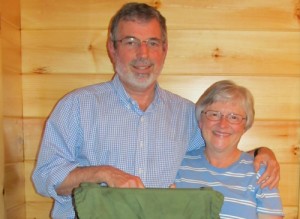By Joyce DeWallace
Contributing Writer

Shrewsbury – Back in the days of Camelot, John F. Kennedy wrote an executive order establishing the Peace Corps as a volunteer program with a three-part mission of providing technical assistance, helping people outside the United State understand American culture, and helping Americans understand other cultures.
Today, 50 years later, more than 200,000 Americans have served in almost 140 countries. Among those are Shrewsbury residents Bob and Gretchen Kossack, who worked as teachers in Nepal in the early 1970s.
“We were implementing a new education program,” Bob said. “It was a major change to a more conceptual education.”
He taught math and science; Gretchen taught English. They came from very different backgrounds. Bob was from central Massachusetts and had attended St. John's High School, then Wesleyan University in Connecticut. Gretchen was the daughter of an American diplomat who worked for the U.S. Agency for International Development; she was a self-described “embassy brat.” Her family moved all over the world. She lived in Europe and Pakistan before coming back to the states. Her junior and senior high school years were spent in the Dominican Republic and India. She graduated from Pomona College in California and then flew to Nepal to join her itinerant family.
After his graduation, Bob boarded an airplane in New York with another 20 or so Peace Corps volunteers and flew more than halfway around the world with stops in London, Frankfort, Beirut, Istanbul, New Delhi, and a final leg to Kathmandu. His group was the first in the program to get their training “in country” rather than in the United States.
After a few days getting acclimated, he flew to Pokhara, where he was trained for three months. He and his fellow Peace Corps volunteers learned the basics of the Nepali language and about some of the local culture. Then he traveled to Dhankuta, where he was assigned to pair up with another math and science teacher. Getting to his destination took several days, including hiking 12 miles up mountains and along a river.
That's when he met Gretchen, who had been teaching English for a year.
“The Peace Corps is a long story for me,” she said. “When we lived in the Dominican Republic, there were lots of Peace Corps volunteers hanging around the house. When I got to Nepal, I was trying to figure out what to do with my life. I went to an embassy party, and spoke to the head of the Peace Corps in Nepal. He said, “Why don's you join the Peace Corps? You can join here.””
So she did.
Her initial three months” training was in Kathmandu, and her assignment took her to the village of Dhankuta, where she taught for two years.
“There was a part of me that thought it would be nice to be out in a village and live very simply, like the Nepali people live,” Gretchen said.
She became friends with the local teachers and spent much of her free time helping them with English.
Bob's posting was two days of travel from Gretchen's. They spent time together when they could, exploring the country, hiking and backpacking. Nepal is in South Asia, home to the Himalayas and Mount Everest. It is bordered to the north by China, and to the south, east, and west by the India.
At the end of 27 months, they were engaged. When Gretchen finished her assignment, she joined her family, who was then living in Virginia. Bob stayed behind until December of 1974, and they were married in February of 1975.
“The Peace Corps clearly gave me an awareness of the world I had not had previously,” Gretchen said.
“Everybody felt they got more out of it than they gave,” Bob said.
The Peace Corps connected two young, idealistic people to each other and to Nepal.
Like so many of the volunteers who have served over the past 50 years, the Kossacks” experience molded their lives and their careers, opening up the world and focusing them on serving others.
As Stanley Meisler, deputy director of the Peace Corps office of evaluation and research. stated, “Half a century after Kennedy's call, the Peace Corps” greatest achievement may be the volunteers themselves.”
















